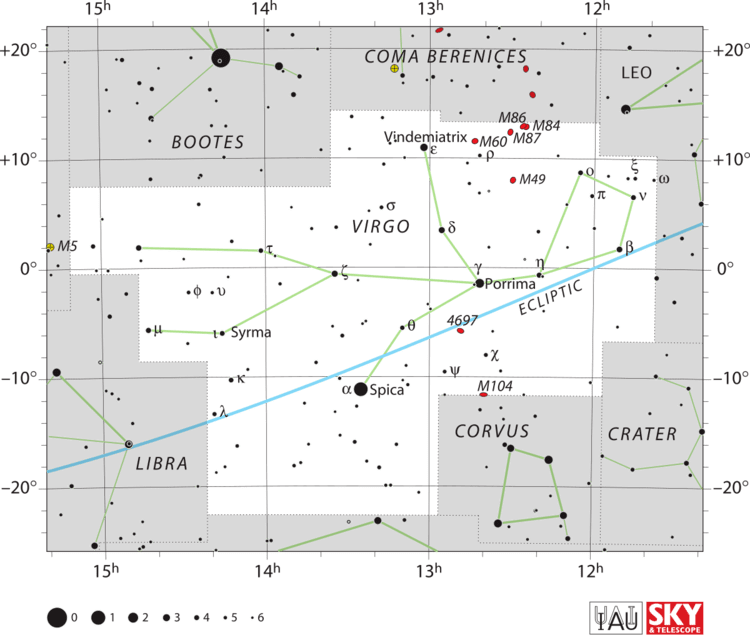Primary η Vir Aa Primary η Vir A | Companion η Vir Ab Companion η Vir B | |
 | ||
Eta Virginis (η Virginis, abbreviated Eta Vir, η Vir), also named Zaniah, is a multiple star system in the zodiac constellation of Virgo. From parallax measurements, it was found to be roughly 265 light-years (81 parsecs) from the Sun. It has an apparent visual magnitude of 3.89, which is bright enough for the system to be seen with the naked eye in dark skies.
Contents
Nomenclature
η Virginis (Latinised to Eta Virginis) is the star's Bayer designation.
It bore the traditional name Zaniah /zəˈnaɪ.ə/, derived from the Arabic زاوية zāwiyah "corner", the same source as Zavijava (Beta Virginis). In 2016, the International Astronomical Union organized a Working Group on Star Names (WGSN) to catalogue and standardize proper names for stars. The WGSN approved the name Zaniah for this star on 12 September 2016 and it is now so entered in the IAU Catalog of Star Names.
In the catalogue of stars in the Calendarium of Al Achsasi Al Mouakket, this star was designated Thanih al Aoua, which was translated into Latin as Secunda Latratoris, meaning "the second barker". This star, along with Beta Virginis (Zavijava), Gamma Virginis (Porrima), Delta Virginis (Auva) and Epsilon Virginis (Vindemiatrix), were Al ʽAwwāʼ, "the Barker".
In Chinese, 太微左垣 (Tài Wēi Zuǒ Yuán), meaning Left Wall of Supreme Palace Enclosure, refers to an asterism consisting of Eta Virginis, Gamma Virginis, Delta Virginis, Epsilon Virginis and Alpha Comae Berenices. Consequently, Eta Virginis itself is known as 太微左垣一 (Tài Wēi Zuǒ Yuán yī, English: the First Star of Left Wall of Supreme Palace Enclosure.), representing 左執法 (Zuǒzhífǎ), meaning "The Left Law Administrator". 左執法 (Zuǒzhífǎ), spelled Tso Chih Fa by R.H. Allen, means "the Left-hand Maintainer of Law"
Properties
Although Eta Virginis looks single, lunar occultations have shown this star to be a very close triple star system consisting of two stars only 0.6 AU apart, assuming a distance of 91 parsecs, with a third slightly more distant star. The inner pair is a spectroscopic binary that completes an orbit with a period of 72 days. The inclination of this orbit was determined through interferometer observations to be 45.5°, which allowed the individual masses of the two stars to be estimated. The primary star, Eta Vir Aa, has a mass of about 2.5 times the Sun's mass, while the secondary, Eta Vir Ab, has 1.9 solar masses. The faint tertiary star, Eta Vir B, orbits the inner group in a wider orbit over a period of 13.1 years.
Because Eta Virginis is near the ecliptic, it can be occulted by the Moon and (very rarely) by planets. On October 12, 272 BC, the ancient Greek astronomer Timocharis observed a conjunction of the star with Venus. The last occultation by a planet took place on September 27, 1843, also by Venus, which will occult it again on November 19, 2445.
